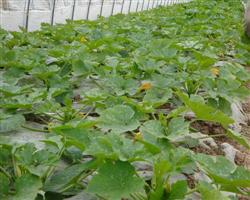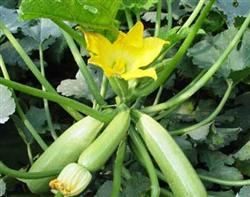Spring zucchini should be protected from more nitrogen and less potassium.

There is more nitrogen and less potassium. The demand of zucchini for nitrogen, phosphorus and potassium is the most, followed by nitrogen and phosphorus. The temperature is higher in spring, if there is too much nitrogen fertilizer, it is easy to cause zucchini to grow too much. Therefore, topdressing in spring must pay attention to less application of nitrogen fertilizer, mainly high potassium compound fertilizer. Protect against high temperature and drought. Zucchini is not resistant to high temperature, high temperature and drought will not only reduce the yield, but also cause virus disease. The temperature is high in spring, if ventilation and watering is not timely, it is easy to cause high temperature and drought in the shed, resulting in the occurrence of virus disease. In addition, the high temperature in the shed, zucchini is easy to grow, causing melons. Therefore, it is necessary to strengthen ventilation and timely watering in spring to avoid the formation of a high-temperature and dry environment in the shed. In general, the temperature in the greenhouse should be controlled at 20 ℃ ~ 24 ℃ in the daytime and 12 ℃ ~ 14 ℃ at night. Timely watering during drought and timely ploughing and loosening soil after watering. Prevent falling flowers and fruits. Artificial pollination is carried out at 6: 8 a.m. every day. The male flowers are picked, the stamens are exposed, and the female style is smeared a few times. Auxin treatment can be treated by spraying or dipping in the newly flowering female flowers containing 20 milligrams per liter or 30 milligrams per liter of anti-falling hormone, which can prevent flowers and fruits from falling and increase the rate of fruit setting. To prevent too many results. In order to prevent the seedlings from falling due to too many fruits in the peak period, it is generally necessary to keep 2 leaves and 1 melon as the appropriate amount of fruit for fruit thinning, and in the later stage, the old leaves and diseased leaves should be removed in time to promote ventilation and light transmission and increase the yield.
- Prev

High-yielding cultivation techniques of summer squash in greenhouse in autumn and winter
1. To select excellent varieties, we should first select the hybrids of early green summer squash with early maturity, high yield, rapid growth and trailing vine characteristics. 2. Cultivate healthy grafted seedlings 1. Sowing time. The sowing time of summer squash in greenhouse autumn and winter is generally from early September to mid-September, and the seed amount per mu is 500 g...
- Next

Grasp the "three tubes" after planting zucchini in spring
The 20-25 days from planting to root melon harvest is the early stage of melon fruiting. The key points of management are heat preservation, water control, mid-tillage, root promotion and seedling protection. After setting the value to 5-7 days before the slow seedling, the herbs should be covered in the morning and evening to keep the greenhouse at 25 ℃ ~ 30 ℃ in the daytime, 15 ℃ ~ 18 ℃ at night, and the ground temperature 20 ℃ ~ 25 ℃. After slowing down the seedlings.
Related
- Where is it suitable to grow horseradish in China? it is expected to see the middle altitude horseradish in Alishan.
- How to prevent tomato virus disease reasonably? (Control methods included)
- Many people like to plant towel gourd on the balcony. What are the main points of this method and management?
- What crops can chili peppers be mixed with?
- Fertilization techniques and matters needing attention in Tomato
- What are the grafting techniques for peach seedlings in spring?
- Harm and control methods of root swelling disease of Chinese cabbage
- What are the pests of sweet potatoes? How to prevent and cure it?
- Symptoms, causes and Control methods of navel Rot in Tomato
- The cause of "Cucumber rotten bibcock" in Farmers' planting Cucumber and its Control Plan

